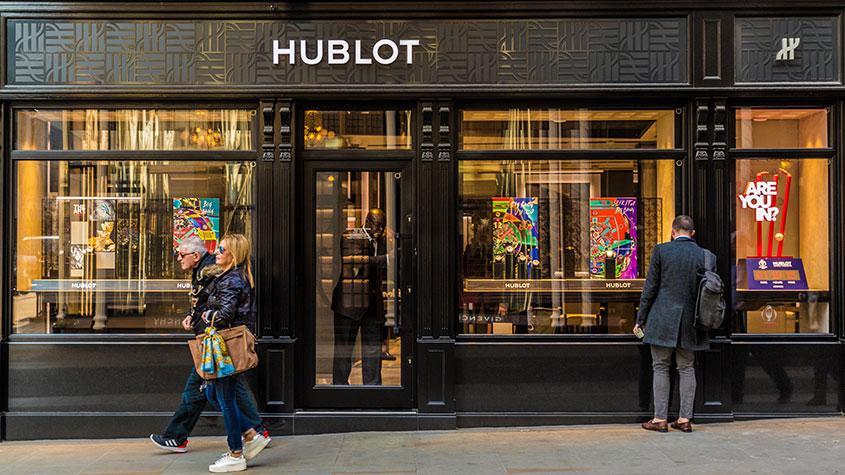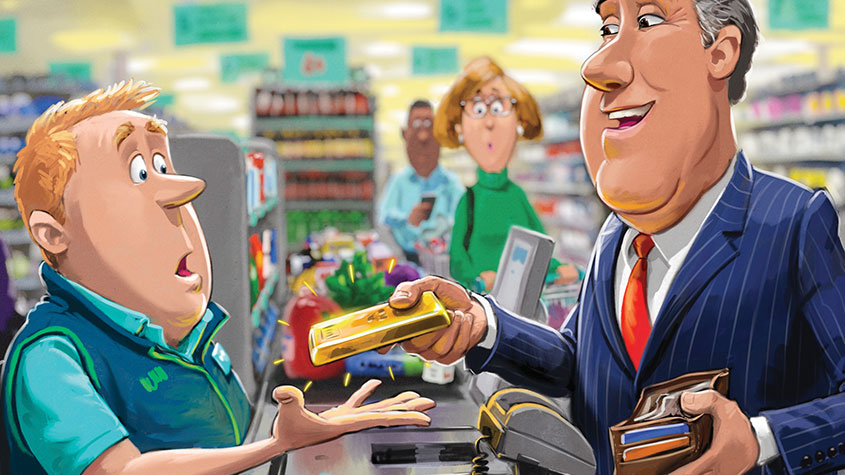The high-street brands that are defying the online onslaught
Times are tough for traditional retailers now internet shopping has taken off. But some big names are successfully adapting to the new environment. What are they doing right? Matthew Partridge investigates.

High noon on the high street. Retail apocalypse. Massacre at the mall. There has been a relentless stream of grim headlines about retailers in crisis in the past few years, and it looks as though 2019 will bring more of the same. Indeed, even before the champagne corks were popped to welcome in the new year, music retailer HMV announced it would be entering administration for the second time; it was resuscitated after going bust in 2013. Meanwhile, Austin Reed, BHS, House of Fraser, Toys R Us, Maplin, Poundworld, Mothercare, New Look and Debenhams (see page 7) are among the high street stalwarts that have either disappeared or may be about to. In the first eight months of 2018, 28 retailers closed 2,085 shops. More than a tenth of retail properties are now vacant.
Moving online
Proximate causes of the downturn include poor real wage growth, rising business rates and careless borrowing to fund expansion. But the most damaging problem is a major structural shift in the way we shop. According to the Office for National Statistics, more than £1 of every £5 in retail sales (20%) is now spent online. A decade ago internet sales comprised just 5% of the total. Amazon alone accounts for £4 of every £100 spent. While the United States has been a little slower to embrace e-commerce, the value of online as a percentage of total retail sales has increased from 4% a decade ago to nearly 10%.
It's not hard to see why more and more people now prefer to shop online. When I was doing my last-minute Christmas shopping I noticed several of the stores at my local shopping centre seemed shabby and unwelcoming. Neither the prices nor the selection were particularly competitive and the overriding impression was that they weren't making a big effort to attract customers. While they might just have got away with this a decade ago , it's economic suicide now Amazon is only a mouse-click or a swipe away.
MoneyWeek
Subscribe to MoneyWeek today and get your first six magazine issues absolutely FREE

Sign up to Money Morning
Don't miss the latest investment and personal finances news, market analysis, plus money-saving tips with our free twice-daily newsletter
Don't miss the latest investment and personal finances news, market analysis, plus money-saving tips with our free twice-daily newsletter
So why do I still think there is value in the high street? For one thing, the online retailers are experiencing problems of their own that could hamper their future growth and even force them to rethink their business model. Meanwhile, the sector has started to absorb the lessons of the past decade and learn how to play to the strengths of the bricks and mortar model. And some chains are going further, completely overhauling their business for the digital age. Here's how to identify them.
Has the trend peaked?
Everyone has "fallen in love" with the online retailers, says Alasdair McKinnon of the Scottish Investment Trust. Their shares are "priced in a way that assumes perfection". However, what everyone overlooks is that the business model of many online retailers is "grossly inefficient". A key problem everyone overlooks is delivery costs. Most online retailers offer free delivery, either automatically or for purchases above a certain amount. While it isn't that difficult to deliver goods to a central warehouse or post office, getting them from there to people's houses (known in the business as the "final mile") without forking out a lot of money is much harder. This means, despite huge amounts already invested in distribution, the online firms remain at a disadvantage compared to traditional retailers "who can get people to come to them".
Online retailers have tried a number of solutions to this problem. One popular alternative to direct doorstep delivery is to encourage people to have packages delivered to their place of employment, especially in large cities where the commercial sector is likely to be somewhere central (such locations also have lower postage costs).
The problem with this is that employers are tired of constantly having to deal with people's parcels, and are beginning to discourage the practice. This means that online companies will need to find an alternative solution, such as paying corner shops to hold people's packages, which will inevitably cost them more money.
An unsustainable model
Getting the goods to the customer is not the only problem firms such as Amazon face. It also has to deal with lots of returns, either because the goods were faulty or because they were ordered in error. While Amazon has tried a variety of schemes to try and cut the cost of covering the postage for these, so far it has had only limited success. In some cases it finds it cheaper simply to refund the money without requiring that the goods be returned (a policy that is clearly open to abuse).
Last September Amazon surprised many people by announcing it was planning to open 3,000 physical stores by 2021. While the company suggested they would be mainly focused on the sorts of products found in your typical convenience store, McKinnon reckons a significant proportion of them may end up being devoted to dealing with returned goods.
The upshot? If online volumes continue to expand, free delivery will become unsustainable. Since many online firms are already operating on wafer-thin margins, absorbing the extra costs isn't an option, so the major internet players face a choice between "either having to increase postage costs, or increasing prices", says McKinnon.
Needless to say, neither option is particularly attractive to consumers. So while most people will still prefer the convenience of buying online, these extra costs will reduce these firms' advantage over traditional retailers, and make them less attractive to consumers. This, in turn, should temper their sales growth and give bricks-and-mortar firms some breathing space.
How retailers are adapting
The trouble online retailers face in maintaining current growth rates isn't the only reason for high- street retailers to be optimistic. The high street is changing rather than dying, say Lisa Hooker, head of consumer at PwC, a consultancy, and Kien Tan, the group's director of retail strategy. "Our research strongly suggests people still like their favourite retailers to have a bricks-and-mortar presence, with four out of five people still regularly visiting stores, even while two out of three people also search online at the same time."
Evidence to support this finding comes from the fact that "click and collect", whereby people pick up goods ordered online at a shop, is now a major growth area, expanding at double the rate of traditional e-commerce. Indeed, this model is taking off so quickly online retailers are now willing to pay traditional retailers large amounts of money for the privilege of using their stores as collection points. For example, Asda has agreed a deal with Asos that sees the website paying Asda to use its stores for both collections and returns. Sainsbury's performs a similar function for the online catalogue firm Argos, which it bought in 2017.
In addition to online firms having to go "cap in hand" to their more established counterparts, the rise of the hybrid "clicks and mortar" model has also encouraged traditional retailers to rethink the way they work. Just as supermarkets have begun to operate more convenience stores because they are shifting away from out-of-town centres, B&Q and Ikea are now also experimenting with smaller shops on high streets.
For example, Ikea has opened a planning studio in Tottenham Court Road, a few hundred yards from MoneyWeek's offices. Instead of wasting valuable space stocking a large amount of inventory, the emphasis in these type of stores is increasingly on showing off goods that can then be ordered and collected or shipped from bigger stores. One retailer that has taken the store-as-showroom idea further than anyone else is the American luxury retailer Nordstrom. It has managed to buck the trend of falling retail sales thanks to the success of its new Nordstrom Local branches. Located in prime urban areas, rather than in dreary shopping malls, they are virtually inventory-free, with the space being devoted mainly to displays, while they also feature entertainment and food.
What to look out for
Of course, not every high-street retailer will be able to survive, let alone thrive, in the high street of the future. So how can you spot the traditional retailers that will do well in the current environment and ensure you steer clear of the ones that won't? Ilana Elbimm of Hermes Investment Management thinks the hallmarks of the success stories of the future include a strong brand identity, a highly enjoyable in-store experience that generates word of mouth, exclusive partnerships, a strong store portfolio with a presence in busy locations and solid balance sheets.
A strong brand identity is important because "it differentiates retailers from their competitors, both online and on the high street, and gives customers a reason to come back", says Elbim. Brand identity and loyalty can be fostered with an in-store experience that makes "customers feel part of a community". One American retailer that does this particularly well is L Brands, which owns both Victoria's Secret and Bath and Body Works. There has been an especially strong emphasis on training staff in recent years. Two years ago it acquired 40,000 iPads for its Victoria's Secret employees, allowing them to watch short training programmes in between helping customers.
In the UK, Primark has managed to offer such a good retail experience it doesn't need to spend money advertising, relying instead on impressed shoppers telling their friends about it. It has evidently fostered great loyalty among consumers with a reputation for offering stylish clothes at very affordable prices, earning the nickname "Primani".
Other companies' efforts to make customers' time in a shop more enjoyable extend beyond putting a branch of a coffee shop or food chain in the same building. Yorkshire Bank, for instance, has opened a branch in Manchester offering fitness classes, film screenings and entrepreneurs giving talks. This is the kind of versatility that retailers faced with the online onslaught are having to display.
Brands can help each other
As well as building up their own reputation, some savvy retailers have been exploiting the appeal of other brands through partnerships with labels or suppliers. Next has set aside a section of its website, known as Label, to sell premium brands such as Ted Baker and Barbour. H&M generated quite a buzz by getting high-fashion label Moschino to produce an exclusive collection for its stores. Because such goods can't be bought elsewhere these agreements encourage customers to come to the stores where they can be persuaded to buy more goods.
All the products in the world won't help you if your customers can't reach you easily. So an efficient store portfolio is also vital. For most retailers this means simultaneously cutting and improving their outlets, leaving them with fewer, but better stores. It's also important for bricks-and-mortar firms not to neglect their online operations since success will come from ensuring the two complement each other. Not only is click-and-collect emerging as a more efficient alternative to delivering directly to the customer, but it also encourages additional impulse purchases once customers have come to the store. Of course, while retailers will need to upgrade stores and websites if they want to survive, this isn't going to be cheap, and will require a lot of additional investment. This is going to be difficult for those who are already under pressure from creditors or a management that is excessively focused on the short term. Retailers with strong balance sheets and cash flow, such as Marks & Spencer, will find it easier than others.
The good news for the retail sector, then, is that the fightback against e-commerce is just beginning. The better news for investors is that the jitters over online competition have led to an "indiscriminate sell-off", says Investors Chronicle's John Hughman, offering a "great opportunity to buy into the bouncing retail babies that have been thrown out with the bath water". We look at some options in the box below.
The stocks and funds to buy for a retail revival
Marks & Spencer (LSE: MKS) has seen its earnings-per-share fall by a quarter since 2011. However, chairman Archie Norman may be able to repeat the success he had with Asda in the 1990s by trimming the number of M&S outlets and updating the clothing selection more rapidly.
Note that the food business, which accounts for about 60% of sales, is less vulnerable to online competition than clothing: only a small percentage of food sales have so far gone online as people want to be able to see and feel the products and they needs to be delivered quickly. On just 11.2 times 2019 earnings, M&S looks cheap. It offers a yield of almost 7%, so investors will be paid handsomely to wait for a turnaround.
Next (LSE: NXT) has also experienced a challenging few years, with sales falling in both 2016 and 2017. However, 2018 seems to have been better, with growth resuming. At the same time, increased online investment, along with an aggressive policy of pruning its property portfolio by closing and sub-letting stores that aren't doing well, has helped profits to continue growing. It plans to increase revenue further by selling access to its distribution network. On 10.9 times 2020 earnings, it looks attractively valued. It yields 3.4%.
Luxury clothing retailer Ted Baker (LSE: TED) has managed to more than double sales in the last six years. An emphasis on small-scale concessions rather than large stores has been key to its success. It has also invested aggressively in its website, which features a virtual reality store. Shares have been hit by a personal scandal involving CEO Ray Kelvin, who has had to take a leave of absence from the company. With strong sales figures over the festive period pointing to further growth, and the stock on a 2020 price/earnings (p/e) ratio of 14.3, it seems good value.
The share price of L Brands (NYSE: LB) has fallen by more than 40% over the past year, thanks partly to a decision to cut the dividend in favour of paying down debt. While the Victoria's Secret chain of stores, whichL Brands owns, has been experiencing problems, they still retain a large degree of customer loyalty.Meanwhile, Body Works,L Brands' other main chain, continues to do well, with sales growing by 7% in 2018. Analysts expect solid growth over the next few years, and plenty of bad news is already priced into the stock given a 2019 p/e ratio of just 10.5.
A fund providing a play on several retailers at once is Aurora Investment Trust (LSE: ARR), whose manager Gary Channon concentrates on brands that are "the lowest-cost operator in both stores and online". That should prevent them "from being undermined by an online competitor".
The trust's second-biggest holding is Sports Direct, while Tesco and Morrisons are also among its top-15 stocks. Aurora has beaten the FTSE All-Share over five and ten years and has an ongoing charge of 0.54%.
Another trust worth a look is the Scottish Investment Trust (LSE: SCIN), run by Alasdair McKinnon. Its biggest holding is Tesco, while Gap, Macy's, Target and Marks & Spencer also feature in its top-15 holdings. It has beaten the FTSE All-Share over the past three, five and ten years and trades at a discount of around 9% to its net asset value. It has an ongoing charge of 0.52%.
Get the latest financial news, insights and expert analysis from our award-winning MoneyWeek team, to help you understand what really matters when it comes to your finances.

-
 Why you fear money – and how to fix it: MoneyWeek Talks
Why you fear money – and how to fix it: MoneyWeek TalksPodcast MoneyWeek's digital editor, Kalpana Fitzpatrick, speaks to financial psychotherapist Vicky Reynal about how to change your money mindset for the better.
-
 How cancelling unused direct debits could boost your pension by £37,000
How cancelling unused direct debits could boost your pension by £37,000A new year refresh of your spending could save you money and help boost your pension pot.
-
 Invest in space: the final frontier for investors
Invest in space: the final frontier for investorsCover Story Matthew Partridge takes a look at how to invest in space, and explores the top stocks to buy to build exposure to this rapidly expanding sector.
-
 Invest in Brazil as the country gets set for growth
Invest in Brazil as the country gets set for growthCover Story It’s time to invest in Brazil as the economic powerhouse looks set to profit from the two key trends of the next 20 years: the global energy transition and population growth, says James McKeigue.
-
 5 of the world’s best stocks
5 of the world’s best stocksCover Story Here are five of the world’s best stocks according to Rupert Hargreaves. He believes all of these businesses have unique advantages that will help them grow.
-
 The best British tech stocks from a thriving sector
The best British tech stocks from a thriving sectorCover Story Move over, Silicon Valley. Over the past two decades the UK has become one of the main global hubs for tech start-ups. Matthew Partridge explains why, and highlights the most promising investments.
-
 Could gold be the basis for a new global currency?
Could gold be the basis for a new global currency?Cover Story Gold has always been the most reliable form of money. Now collaboration between China and Russia could lead to a new gold-backed means of exchange – giving prices a big boost, says Dominic Frisby
-
 How to invest in videogames – a Great British success story
How to invest in videogames – a Great British success storyCover Story The pandemic gave the videogame sector a big boost, and that strong growth will endure. Bruce Packard provides an overview of the global outlook and assesses the four key UK-listed gaming firms.
-
 How to invest in smart factories as the “fourth industrial revolution” arrives
How to invest in smart factories as the “fourth industrial revolution” arrivesCover Story Exciting new technologies and trends are coming together to change the face of manufacturing. Matthew Partridge looks at the companies that will drive the fourth industrial revolution.
-
 Why now is a good time to buy diamond miners
Why now is a good time to buy diamond minersCover Story Demand for the gems is set to outstrip supply, making it a good time to buy miners, says David J. Stevenson.